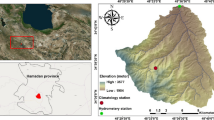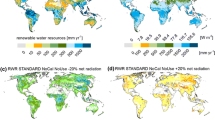Abstract
The development of Hydro-Informatic Modelling System (HIMS) provides an integrated platform for hydrological simulation. To extend the application of HIMS, an ecohydrological modeling system named ecohydrological assessment tool (EcoHAT) has been developed. Integrating parameter-management tools, RS (remote sensing) inversion tools, module-design tools and GIS analysis tools, the EcoHAT provides an integrated tool to simulate ecohydrological processes on regional scale, which develops a new method on sustainable use of water. EcoHAT has been applied to several case studies, such as, the Yellow River Basin, the acid deposition area in Guizhou province and the riparian catchment of Guanting reservoir in Beijing. Results prove that EcoHAT can efficiently simulate and analysis the ecohydrological processes on regional scale and provide technical support to integrated water resources management on basin scale.
Similar content being viewed by others
References
Liu C M, Wang Z G, Zheng H X, et al. Development of hydro-informatic modelling system and its application. Sci China Ser E-Tech Sci, 2008, 51(4): 456–466
IGBP. Predicting global change impacts on moumtain hydrology and ecology. IGBP Report 43, 1997
Zalewski M. Ecohydrology—the scientific background to use ecosystem properties as management tools toward sustainability of water resources. Ecol Eng, 2000, 16(1): 1–8
Neitsch S L, Arnold J G, Kiniry J R, et al. Soil and water assessment tool theoretical documentation version 2005. http://www.brc.tamus.edu/swat/
Krysanova V, Wechsung F, Arnold J G, et al. SWIM user manual. PIK Report No. 69, 2000
Liu C M. Study on interface processes of water cycle in soil-plant-atmosphere continuum. Acta Geogr Sinica. 1997, 52(4): 366–372
Liu C M, Sun R. Ecological aspects of water cycle: advances in soil vegetation atmosphere of energy and water fuxes. Adv Water Sci, 1999, 10(3): 251–259
Wang G X, Liu G N, Chang J. Review on some issues of ecohydrology research at the watershed scale. Acta Ecol Sinica, 2005(4): 892–903
Liu C M, Yang S T, Sun R. Water Cycle Elements Research in the Yellow River Basin Based on RS/GIS Technology. Zhengzhou: Yellow River Conservancy Press, 2006
Rodriguez-Iturbe I. Ecohydrology: A hydrologic perspective of climate-soil-vegetation dynamics. Water Resour Res, 2000, 36(1): 3–9
Rao N H. Field test of a simple soil water balance model for irrigated areas. Hydrol, 1987, 91(2): 179–186
DEJong R, Cameron D R. Computer simulation model for predicting soil water content profiles. Soil Sci, 1979, 128(1): 41–48
Lei Z D, Yang S X, Xie S C. Soil Water Dynamics. Beijing: Qinghua University Press, 1988
Jones C A. CERES-Maize: A Simulation Model of Maize Growth and Development. Texas: TEXAS A and M University Press, 1986. 79–90
Molz F J, Irwin R. Models of water transport in the soil-plant system: a review. Water Resour Res, 1981, 17(5): 1245–1260
Marius H. Simplified denitrification models: overview and properties. Geoderma, 2006, 133(4): 444–463
Inamdar S P, Lowrance R R, Altier L S, et al. Riparian ecosystem management model (REMM): II. Testing of the water quality and nutrient cycling component for a coastal plain riparian system. Trans ASAE, 1999, 42(8): 1691–1707
Grundmann G L, Rolston D E. A water function approximation to degree of anaerobiosis associated with denitrification. Soil Sci, 1987, 144(6): 437–441
Xu C, Shaffer M J, Al-Kaisi M. Simulating the impact of management practices on nitrous oxide emissions. Soil Sci Soc Am J, 1998, 62(6): 736–742
Kros H. Evaluation of Biogeochemical Models at Local and Regional Scale. Dissertation of Doctoral Degree. Netherlands: Wageningen Agricultural University Press, 2002. 284
Li C S, Aber J. A process-oriented model of N2O and NO emissions from froest soils model development. J Geophys Res, 2000, 105(D4): 4369–4384
Zhu Z X, Arp P A, Meng F, et al. A forest nutrient cycling and biomass model (ForNBM) based on year-round, monthly weather conditions, II: Calibration, verification, and application. Ecol Model, 2003, 170(1): 13–27
Arp P A, Oja T. A forest soil vegetation atmosphere model (ForSVA), I: Concepts. Ecol Model, 1997, 95(2): 211–224
Cosby B J, Wright R F, Hornberger G M, et al. Modeling the effects of acid deposition: estimation of long-term water quality response in a small forested catchment. Water Resour Res, 1985, 20(11): 1591–1601
Arp P A, Oja T. A forest soil vegetation atmosphere model (ForSVA), II: Application to northern tolerant hardwoods. Ecol Model, 1997, 95(2): 245–247
Zhu Z X, Arp P A, Meng F R, et al. A forest nutrient cycling and biomass model (ForNBM) based on year-round, monthly weather conditions, part I: assumption, structure and processing. Ecol Model, 2003, 169(3): 347–360
Tan Q Q, Bi J T, Chi T H. A flexible and efficient algorithm for constructing remote sensing image pyramid. Comp Syst & Appl, 2008, 4(1): 124–127
Wang X L. Non Point Source Pollution Analysis and Digital Simulation in Riparian Basin of Waterhead Areas. Dissertation of Doctoral Degree. Beijing: Beijing Normal University, 2008. 47–57
Author information
Authors and Affiliations
Corresponding author
Additional information
Supported by the National Key Technology R&D Program in the 11th Five-year Plan of China (Grant No. 2006BAB06B07), the National Natural Science Foundation of China (Grant No. 40671123), the National Basic Research Program of China (“973” Project) (Grant Nos. 2005CB422207, G19990436), and the National Hi-Tech Research and Development Program of China (“863” Project) (Grant No. 2006AA12Z145)
Rights and permissions
About this article
Cite this article
Liu, C., Yang, S., Wen, Z. et al. Development of ecohydrological assessment tool and its application. Sci. China Ser. E-Technol. Sci. 52, 1947–1957 (2009). https://doi.org/10.1007/s11431-009-0199-9
Received:
Accepted:
Published:
Issue Date:
DOI: https://doi.org/10.1007/s11431-009-0199-9




